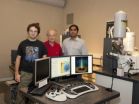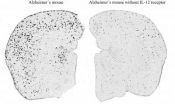(Press-News.org) A large number of friends on Facebook may appear impressive but, according to a new report, the more social circles a person is linked to online the more likely social media will be a source of stress.
A report from the University of Edinburgh Business School has found that the more groups of people in someone's Facebook friends, the greater potential to cause offence. In particular, adding employers or parents resulted in the greatest increase in anxiety.
Stress arises when a user presents a version of themself on Facebook that is unacceptable to some of their online 'friends', such as posts displaying behaviour such as swearing, recklessness, drinking and smoking.
As older people join the site, this has become an increasing problem as their expectations may be very different from those of younger users.
Some 55 per cent of parents follow their children on Facebook. Likewise, more than half of employers claim not to have hired someone based on their Facebook page.
Researchers found that on average people are Facebook friends with seven different social circles. The most common group was friends known offline (97 per cent added them as friends online), followed by extended family (81 per cent), siblings (80 per cent), friends of friends (69 per cent), and colleagues (65 per cent).
The report also discovered that more people are Facebook friends with their former partners than with their current relationship partner. Only 56 per cent of users were friends with their boyfriend, girlfriend or spouse online, compared with 64 per cent of exes.
The report surveyed more than 300 people on Facebook, mostly students, with an average age of 21.
It also discovered that only one third use the listing privacy setting on their Facebook profile, which can be used to control the information seen by different types of friends.
Ben Marder, author of the report and early career fellow in marketing at the Business School, said: "Facebook used to be like a great party for all your friends where you can dance, drink and flirt. But now with your Mum, Dad and boss there the party becomes an anxious event full of potential social landmines."
### END
More Facebook friends means more stress, says report
2012-11-26
ELSE PRESS RELEASES FROM THIS DATE:
Crash landings
2012-11-26
Diagnosing an injury in a swan is a far from easy undertaking. Not only are swans large, frequently weighing over 10 kg, but they are generally not happy at being handled and thus many of them can only be examined after sedation, which naturally represents a risk. The hip joints of many species of bird are known to be vulnerable to injury but swans are believed to suffer broken hips only rarely. The traditional way of examining the birds' hips relies on radiography but Gumpenberger and Scope now show that computerized tomography (CT) gives more reliable findings.
The ...
Release all Tamiflu data as promised, argue researchers
2012-11-26
The latest correspondence is posted online today as part of the BMJ's open data campaign, aimed at persuading Roche to honour the promise it made almost three years ago to make key Tamiflu trial data available for independent scrutiny.
Last week, Donald MacLean, Life Cycle Leader for Tamiflu, wrote to Professor Chris Del Mar in his capacity as coordinating editor of the Cochrane Acute Respiratory Infections Group, concerning "our debate on Tamiflu data."
The Cochrane researchers say they object to Roche's suggestion that there is a debate on Tamiflu data. "There is ...
How does a volcanic crater grow? Grab some TNT and find out
2012-11-26
BUFFALO, N.Y. -- A new University at Buffalo study in the journal Geophysical Research Letters examines maar craters, which resemble the bowl-like cavities formed by meteorites but are in some ways more mysterious.
Scientists often can discern pertinent details about meteorites -- when they struck, how large they were, the angle they approached Earth and other information -- by measuring the diameter and volume of the impact crater.
Maar craters, which form when fissures of magma beneath Earth's surface meet groundwater, causing volcanic explosions, are not as telling, ...
BioMAP screening procedure could streamline search for new antibiotics
2012-11-26
Researchers at the University of California, Santa Cruz, have developed a new strategy for finding novel antibiotic compounds, using a diagnostic panel of bacterial strains for screening chemical extracts from natural sources.
Public health officials warn of a looming antibiotic crisis due to the steady increase in antibiotic resistance and a dramatic decline in the development of new antibiotics. Most currently available antibiotics are derived from natural compounds produced by microorganisms such as bacteria and fungi. New antibiotics developed by drug companies are ...
New device hides, on cue, from infrared cameras
2012-11-26
Cambridge, Mass. - November 26, 2012 - Now you see it, now you don't.
A new device invented at the Harvard School of Engineering and Applied Sciences (SEAS) can absorb 99.75% of infrared light that shines on it. When activated, it appears black to infrared cameras.
Composed of just a 180-nanometer-thick layer of vanadium dioxide (VO2) on top of a sheet of sapphire, the device reacts to temperature changes by reflecting dramatically more or less infrared light.
Announced today in the journal Applied Physics Letters, and featured on its cover, this perfect absorber ...
Seizures linked to surgery drugs can be prevented by anesthetics, U of T team finds
2012-11-26
Two drugs commonly given during cardiac surgery can lead to convulsive seizures, but anesthetics can help cut the risk, according to new research from the Faculty of Medicine at the University of Toronto.
Patients undergoing complex heart operations or trauma surgery are often given tranexamic acid (TXA) and aminocaproic acid (EACA) to reduce blood loss. But Faculty of Medicine researchers found these drugs are associated with a four-to-six-fold increase in post-operative seizures. The risk is highest for cardiac surgery patients – between three and seven and a half per ...
Researchers test novel power system for space travel
2012-11-26
LOS ALAMOS, N.M., Nov. 26, 2012 — A team of researchers, including engineers from Los Alamos National Laboratory, has demonstrated a new concept for a reliable nuclear reactor that could be used on space flights.
The research team recently demonstrated the first use of a heat pipe to cool a small nuclear reactor and power a Stirling engine at the Nevada National Security Site's Device Assembly Facility near Las Vegas. The Demonstration Using Flattop Fissions (DUFF) experiment produced 24 watts of electricity. A team of engineers from Los Alamos, the NASA Glenn Research ...
Cyber Monday at CocktailNerd Brings the Biggest E-Cig Savings of 2012
2012-11-26
Cyber Monday is here and it brings one last chance for electronic cigarette fans to save big on all of their favorite e-cig starter kits and accessories. CocktailNerd.com is offering readers big savings on Cyber Monday with exclusive deals that will expire at midnight. This is the year's biggest sale on all of the best electronic cigarettes brands and with exclusive coupon codes from Cocktail Nerd, e-cig shoppers can save up to 65% on all of their favorite products.
Cocktail Nerd is the Internet's most cutting edge website for e-cig news, reviews, and savings. The site ...
Alzheimer's disease in mice alleviated promising therapeutic approach for humans
2012-11-26
Alzheimer's disease is one of the most common causes of dementia. In Germany and Switzerland alone, around 1.5 million people are affected, and forecasts predict a doubling of the number of patients worldwide within the next 20 years. The accumulation of particular abnormal proteins, including amyloid-ß (Aβ) among others, in patients' brains plays a central role in this disease. Prof. Frank Heppner from the Department of Neuropathology at Charité and his colleague Prof. Burkhard Becher from the Institute for Experimental Immunology at the University of Zurich were ...
Patient's own immune cells may blunt viral therapy for brain cancer
2012-11-26
COLUMBUS, Ohio – Doctors now use cancer-killing viruses to treat some patients with lethal, fast-growing brain tumors. Clinical trials show that these therapeutic viruses are safe but less effective than expected.
A new study led by researchers at the Ohio State University Comprehensive Cancer Center – Arthur G. James Cancer Hospital and Richard J. Solove Research Institute (OSUCCC – James) shows that the reason for this is in part due to the patient's own immune system, which quickly works to eliminate the anticancer virus.
The findings, published in the journal Nature ...

